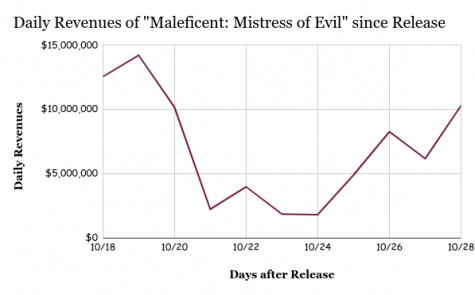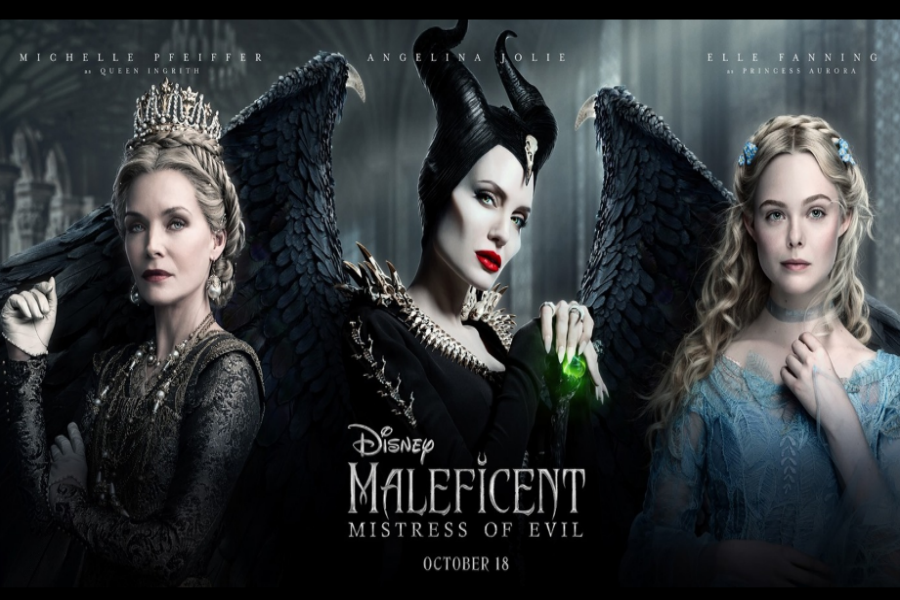“Mistress of Evil”: one of Disney’s best live-action remakes
October 31, 2019
Since “Sleeping Beauty” first came out, little girls dreamed that they would be woken up from their slumber by true love’s kiss, after having been cursed by evil Maleficent. Director Joachim Ronning again brings light to the true, loving nature of this enchantress in his second installment to the Maleficent series: Mistress of Evil.
The Maleficent saga stars Angelina Jolie and Elle Fanning in the lead roles of Maleficent and Princess Aurora: their acting was nothing short of impressive. Ronning’s first installment explores Maleficent’s past as a genuinely kind fairy creature who grows bitter and vengeful from a human king’s betrayal. Years later, Aurora, a human, becomes omnipresent within Maleficent’s life, and the two form an unorthodox mother-daughter relationship; Aurora eventually becomes the tool that slowly changes Maleficent into her past self.
“Mistress of Evil” surprisingly, does not pick up where the previous film had left off; the new film is set many years later. The human kingdom that was the primary cause of tension in the first film is completely forgotten, and replaced by a kingdom known as Ulstead, home of Prince Philip. Aurora kindles a relationship with the prince, causing issues between the human and fairy worlds. The second installment captures the choices Maleficent and Aurora make whether to stick together as a family or support their own kinds.
Overall, Ronning’s sequel offers a compatible and fairly logical continuation of its predecessor. With an impressive budget of $185 million, the second movie presented impressive visuals improved upon from the first, perfectly capturing the majesty of the Moor and Ulstead kingdoms. The muted colors used throughout are fitting, and the film’s presentation of Maleficent’s unmistakable physical features, such as her horns and wings, are commendable. The thoughtful costuming was one of my personal favorite components of the film.
I also appreciated the greater character diversity in the second film: the introduction of fairies from different parts of the world, rather than focusing on just two characters from a medieval setting as the first film had.
I truly believe as though the visuals and casting were the two main components of the film that have allowed the movie to perform as well as it has in the box office.

Daily grossings of “Maleficent: Mistress of Evil” since its release, according to Boxoffice Mojo
In addition, the background score of the film was another one of the most enjoyable parts of the movie. The music transitioned seamlessly from scene to scene, and it offered a powerful alternative to pure dialogue. The music was also a key component in conveying different moods, such as the use of trumpets and drums to mimic the beating of a heart during war scenes.
Speaking of these types of more serious scenes, “Mistress of Evil” has a more complex and action-packed plotline than the first installment. The story consistently moves at a brisk pace, so I was always on the edge of my seat waiting for more, and its multiple plot twists add so many layers to the well-known tale of “Sleeping Beauty.”
This more serious nature of “Maleficent 2” made me rethink the film’s appropriateness for the young audience that the film is intended to cater to. No gory or inappropriate details are included, but a solid third of the movie contains content regarding war and self-sacrifice that may be too violent for some children to handle.
Although I generally enjoyed the film, there were some components that I had an issue with. One of my greatest issues was that it seemed to regress Maleficent’s character that she had built by the end of the first film. The first film ultimately presented Maleficent as a changed person who forsook her vengeful past and became a loving mother-figure to Aurora. The second film portrayed Maleficent as more vengeful and reclusive, but Maleficent reached the same moral climax that she had at the first film, which seemed unnecessary and illogical. I appreciated that the movie presented some character growth in Maleficent and Aurora, especially during end scene when Maleficent’s vulnerability came through, but I do wish as though this growth was either more prolific or was not addressed at all rather than in the middle.
This, however, wasn’t the only time the second film seems to readdress ideas fully established in the first installment. Both films focused on the complicated dynamic between the Moors kingdom and a human kingdom, which seemed redundant.
These issues were echoed by others who watched the film with me.
“Some parts were kind of cheesy and repetitive, but it’s supposed to be a lighthearted Disney movie so it makes sense,” an anonymous movie-goer said.
Overall, “Maleficent: Mistress of Evil” met my expectations as much as its predecessor. The film’s few plot and character development issues are negligible compared to the outstanding acting, visuals, and other creative components. Although the film may be considered a bit mature for younger audiences, “Mistress of Evil” is another successful, highly-rewatchable Disney sequel I would highly recommend experiencing.
8.5/10









Subha • Oct 31, 2019 at 10:26 pm
Great article Sri. Useful review!